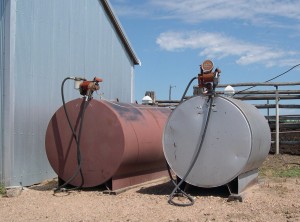The Water Resources Reform and Development Act (WRRDA), which became law on June 10, 2014, changed the SPCC rules.
 Previously, the EPA SPCC rule for farms required compliance if an operation had 1,320 gallons, or more, of aboveground fuel storage and allowed self-certification up to 10,000 gallons. This not only included fuel storage but required aboveground feed storage to be included in the total if it met the broad definition of “oil” which includes the base of many liquid cattle feeds.
Previously, the EPA SPCC rule for farms required compliance if an operation had 1,320 gallons, or more, of aboveground fuel storage and allowed self-certification up to 10,000 gallons. This not only included fuel storage but required aboveground feed storage to be included in the total if it met the broad definition of “oil” which includes the base of many liquid cattle feeds.
Under the provision in the WRRDA Act, the aggregate aboveground fuel exemption limit is raised to 6,000 gallons for operations with no history of spills and no single tank with a capacity of 10,000 gallons or more from having to develop a plan. The provision will require a self-certified plan for operations that have aggregate aboveground fuel storage above 6,000 and below 20,000 gallons with no history of spills and no single tank capacity of 10,000 gallons or more. Moreover, the legislation exempts fuel tanks with a capacity of 1,000 gallons or less and all tanks that hold animal feed ingredients from the aggregate calculations. Those operations that do not meet these exemptions will require a Spill Containment Plan, certified by a professional engineer.
The legislation also calls for a study to be conducted by the EPA and the USDA within one year of the bill becoming law to determine whether the 6,000 gallon aggregate aboveground storage exemption level poses a significant risk of a discharge to waters of the U.S. by agricultural operations. Based on the results of that study, the exemption level may be lowered from 6,000 gallons, but cannot be lowered below 2,500 gallons.
If you have questions about SPCC rules or believe you need an SPCC plan, feel free to contact Brink, Inc.

